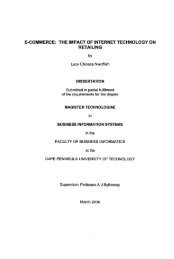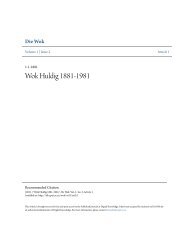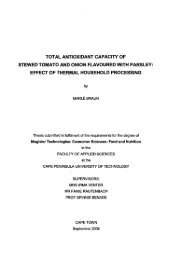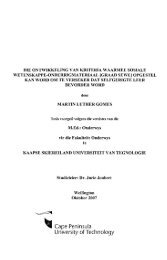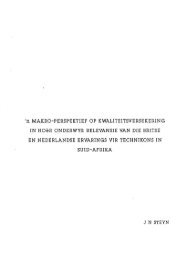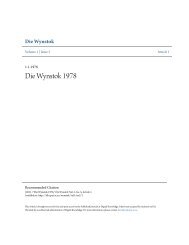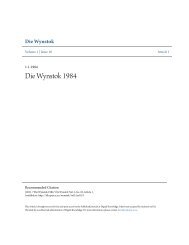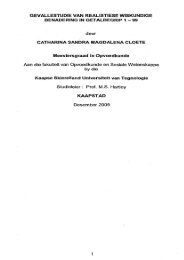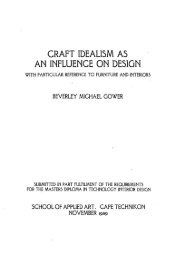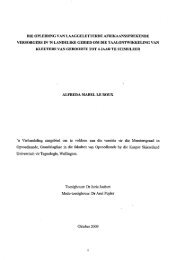the effect of the particle size distribution on non-newtonian turbulent ...
the effect of the particle size distribution on non-newtonian turbulent ...
the effect of the particle size distribution on non-newtonian turbulent ...
Create successful ePaper yourself
Turn your PDF publications into a flip-book with our unique Google optimized e-Paper software.
Chapter 2 Literature Review Page 2.8<br />
... Cb) Particle Shape<br />
In a Newt<strong>on</strong>ian liquid, if <str<strong>on</strong>g>the</str<strong>on</strong>g> solid <str<strong>on</strong>g>particle</str<strong>on</strong>g>s are rigid spherical <str<strong>on</strong>g>particle</str<strong>on</strong>g>s, <str<strong>on</strong>g>the</str<strong>on</strong>g>y impart<br />
pseudoplastic behaviour. Rigid ellipsoidal and elastic spherical <str<strong>on</strong>g>particle</str<strong>on</strong>g>s will normally<br />
result in visco-elastic behaviour (Charles & Kenchingt<strong>on</strong>, 1976).<br />
I (c) C<strong>on</strong>centrati<strong>on</strong><br />
The increase <str<strong>on</strong>g>of</str<strong>on</strong>g> solids c<strong>on</strong>centrati<strong>on</strong> increases <str<strong>on</strong>g>the</str<strong>on</strong>g> degree <str<strong>on</strong>g>of</str<strong>on</strong>g>n<strong>on</strong>-Newt<strong>on</strong>ian behaviour<br />
and larger <str<strong>on</strong>g>particle</str<strong>on</strong>g>s may form a n<strong>on</strong>-Newt<strong>on</strong>ian mixture at increased c<strong>on</strong>centrati<strong>on</strong><br />
(Lazarus, 1992). Thomas (1963) showed that for <str<strong>on</strong>g>particle</str<strong>on</strong>g>s in <str<strong>on</strong>g>the</str<strong>on</strong>g> range 0,35 to 13 Itm<br />
<str<strong>on</strong>g>the</str<strong>on</strong>g> yield stress is inversely proporti<strong>on</strong>al to <str<strong>on</strong>g>the</str<strong>on</strong>g> <str<strong>on</strong>g>particle</str<strong>on</strong>g> diameter and proporti<strong>on</strong>al to<br />
<str<strong>on</strong>g>the</str<strong>on</strong>g> cube <str<strong>on</strong>g>of</str<strong>on</strong>g> <str<strong>on</strong>g>the</str<strong>on</strong>g> volumetric c<strong>on</strong>centrati<strong>on</strong>.<br />
I (d) Reynolds Number<br />
Athigh Reynolds numbers n<strong>on</strong>-Newt<strong>on</strong>ian behaviour decreases (Lazarus, 1992). This<br />
is due to <str<strong>on</strong>g>the</str<strong>on</strong>g> fact that <strong>turbulent</strong> flow <str<strong>on</strong>g>of</str<strong>on</strong>g> n<strong>on</strong>-Newt<strong>on</strong>ian fluids at high Reynolds<br />
numbers is characterized by increased inertial forces compared with <str<strong>on</strong>g>the</str<strong>on</strong>g> viscous<br />
forces. This is in c<strong>on</strong>tradicti<strong>on</strong> to <str<strong>on</strong>g>the</str<strong>on</strong>g> findings <str<strong>on</strong>g>of</str<strong>on</strong>g> Weltman (1948) (see secti<strong>on</strong><br />
2.5.1). In laminar flow and at "low Reynolds numbers <str<strong>on</strong>g>the</str<strong>on</strong>g> n<strong>on</strong>-Newt<strong>on</strong>ian<br />
characteristics or behaviour becomes more prominent.<br />
2.6 SLURRY CLASSIFICATION<br />
Solid-liquid suspensi<strong>on</strong>s (ie. slurries) can be classified in <strong>on</strong>e <str<strong>on</strong>g>of</str<strong>on</strong>g> two regimes according to<br />
<str<strong>on</strong>g>the</str<strong>on</strong>g> manner in which <str<strong>on</strong>g>the</str<strong>on</strong>g>y flow.<br />
2.6.1 Homogeneous Slurries<br />
This type <str<strong>on</strong>g>of</str<strong>on</strong>g>slurry <str<strong>on</strong>g>of</str<strong>on</strong>g>ten exhibits n<strong>on</strong>-Newt<strong>on</strong>ian rheology (Thomas 1976, Lazarus 1992) and<br />
although it is characterized by a uniform c<strong>on</strong>centrati<strong>on</strong> <str<strong>on</strong>g>of</str<strong>on</strong>g> <str<strong>on</strong>g>particle</str<strong>on</strong>g>s about <str<strong>on</strong>g>the</str<strong>on</strong>g> axis <str<strong>on</strong>g>of</str<strong>on</strong>g> <str<strong>on</strong>g>the</str<strong>on</strong>g> pipe,<br />
it flows as a single-phase fluid (Thomas 1976). This definiti<strong>on</strong> encompasses n<strong>on</strong>-settling




